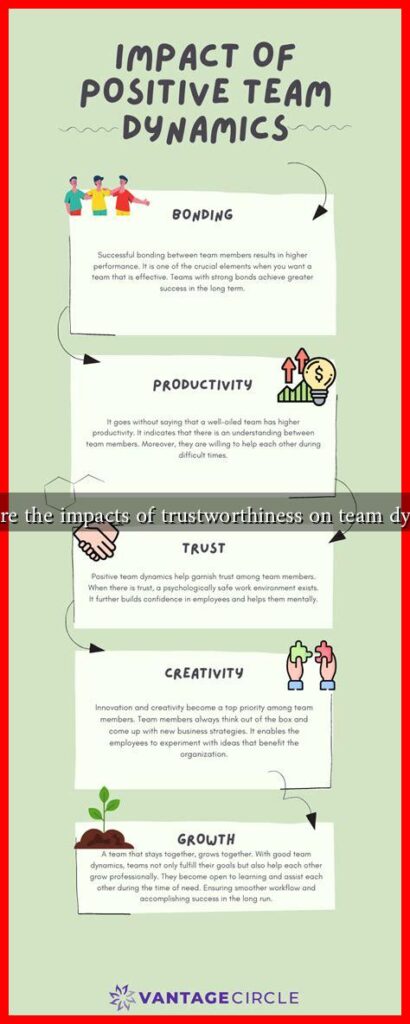-
Table of Contents
- The Impacts of Trustworthiness on Team Dynamics
- Understanding Trustworthiness in Teams
- The Role of Trustworthiness in Team Dynamics
- Case Studies Highlighting the Importance of Trustworthiness
- Case Study 1: Google’s Project Aristotle
- Case Study 2: The Navy SEALs
- Statistics on Trust and Team Performance
- Building Trustworthiness in Teams
- Conclusion
The Impacts of Trustworthiness on Team Dynamics
In today’s fast-paced and interconnected work environment, the dynamics of a team can significantly influence its overall performance and success. One of the most critical factors that shape these dynamics is trustworthiness. Trustworthiness not only fosters collaboration but also enhances communication, creativity, and productivity within teams. This article explores the multifaceted impacts of trustworthiness on team dynamics, supported by research, examples, and case studies.
Understanding Trustworthiness in Teams
Trustworthiness can be defined as the quality of being reliable, honest, and ethical. In a team context, it refers to the belief that team members will act in the best interest of the group and uphold their commitments. Trustworthiness is built over time through consistent actions, open communication, and mutual respect.
The Role of Trustworthiness in Team Dynamics
Trustworthiness plays a pivotal role in shaping various aspects of team dynamics. Here are some key areas where its impact is most evident:
- Communication: Trustworthy teams tend to have open lines of communication. Members feel safe sharing their ideas and concerns without fear of judgment. This openness leads to more effective problem-solving and innovation.
- Collaboration: When team members trust each other, they are more likely to collaborate effectively. Trust reduces the need for micromanagement and allows individuals to take ownership of their tasks.
- Conflict Resolution: In a trustworthy environment, conflicts are addressed constructively. Team members are more willing to engage in healthy debates and find solutions rather than resorting to avoidance or hostility.
- Morale and Motivation: Trustworthiness boosts team morale. When individuals feel trusted, they are more motivated to contribute their best efforts, leading to higher overall productivity.
Case Studies Highlighting the Importance of Trustworthiness
Several organizations have recognized the importance of trustworthiness in enhancing team dynamics. Here are a couple of notable examples:
Case Study 1: Google’s Project Aristotle
Google conducted a study known as Project Aristotle to identify the key factors that contribute to effective teams. The research revealed that psychological safety, which is closely linked to trustworthiness, was the most significant factor. Teams that felt safe to take risks and express their thoughts without fear of negative consequences performed better than those that did not.
Case Study 2: The Navy SEALs
The Navy SEALs are renowned for their exceptional teamwork and performance under pressure. A critical component of their success is the high level of trust among team members. This trust is cultivated through rigorous training and shared experiences, allowing them to rely on one another in life-or-death situations.
Statistics on Trust and Team Performance
Research supports the notion that trustworthiness significantly impacts team performance. According to a study published in the Harvard Business Review, teams with high trust levels are 50% more productive than those with low trust. Furthermore, organizations with high trust levels report 74% lower stress levels among employees, leading to improved job satisfaction and retention rates.
Building Trustworthiness in Teams
To harness the benefits of trustworthiness, organizations must actively work to build and maintain it within their teams. Here are some strategies:
- Encourage Open Communication: Create an environment where team members feel comfortable sharing their thoughts and feedback.
- Lead by Example: Leaders should model trustworthy behavior by being transparent, reliable, and accountable.
- Foster Team-Building Activities: Engage in activities that promote bonding and understanding among team members.
- Recognize and Reward Trustworthy Behavior: Acknowledge and celebrate instances where team members demonstrate trustworthiness.
Conclusion
Trustworthiness is a cornerstone of effective team dynamics. It enhances communication, collaboration, conflict resolution, and overall morale. Organizations that prioritize building trust within their teams are likely to experience improved performance, higher employee satisfaction, and lower turnover rates. By understanding the profound impacts of trustworthiness and implementing strategies to cultivate it, teams can unlock their full potential and achieve remarkable results.


